


Fig-SPM.1 Reference and Stabilization Scenarios for Global Anthropogenic CO2 Emissions (GtC) The figure is divided into six parts, one for each of the reference scenario groups from the Special Report on Emissions Scenarios (SRES, see Box SPM.1). Each part of the figure shows the range of total global CO2 emissions (gigatonnes of carbon (GtC)) from all anthropogenic sources for the SRES reference scenario group (shaded in grey) and the ranges for the various mitigation scenarios assessed in the TAR leading to stabilization of CO2 concentrations at various levels (shaded in colour) A1 - Rapid Global Growth Scenario
A1B - The Balanced Scenario
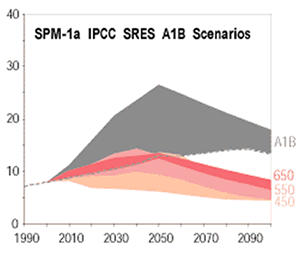
A1T - The Non-Fossil Fuel Scenario
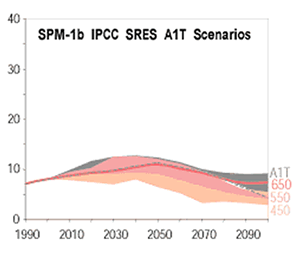
A1FI - The Fossil-Fuel Intensive Scenario
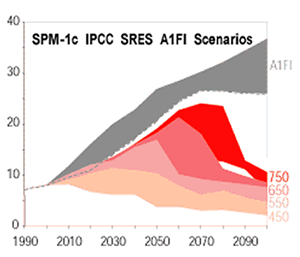
A2 - Regional Growth Scenario
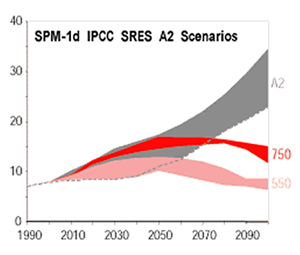
B1 - Global Service Economy Scenario
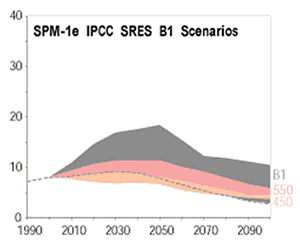
B2 - Increasing Population Scenario
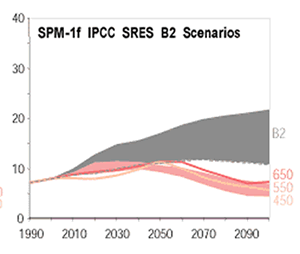 Figure SPM.1: Comparison of reference and stabilization scenarios. Scenarios are presented for the A1 family subdivided into three groups (the balanced A1B group (Figure SPM.1a), non-fossil fuel A1T (Figure SPM.1b) and the fossil intensive A1FI (Figure SPM.1c)) with stabilization of CO2 concentrations at 450, 550, 650 and 750 ppmv; for the A2 group with stabilization at 550 and 750 ppmv in Figure SPM.1d, the B1 group with stabilization at 450 and 550 ppmv in Figure SPM.1e, and the B2 group with stabilization at 450, 550 and 650 ppmv in Figure SPM.1f. The literature is not available to assess 1000 ppmv stabilization scenarios. The figure illustrates that the lower the stabilization level and the higher the baseline emissions, the wider the gap. The difference between emissions in different scenario groups can be as large as the gap between reference and stabilization scenarios within one scenario group. The dotted lines depict the boundaries of the ranges where they overlap. Source & ©
IPCC TAR SPM of WG III Related publication:
Other Figures & Tables on this publication: Adaptive Capacity, Vulnerability, and Key Concerns by Region Facts on environmental matters Table SPM.1 Estimates of potential global greenhouse gas emission reductions in 2010 and in 2020 The Emissions Scenarios from the Special Report on Emissions Scenarios (SRES) Expert Links on Climate Change Expert Links on Climate Change Expert Links on Climate Change Expert Links on Climate Change Expert Links on Climate Change Expert Links on Climate Change Expert Links on Climate Change Footnotes for the Summary for Policymakers of IPCC Working Group III Footnotes for Table 1 of IPCC SPM WG II Footnotes for the Summary for Policymakers of IPCC Working Group 1 Footnotes for the Summary for Policymakers of IPCC Working Group II Variations of the Earth's surface temperature for : Indicators of the human influence on the atmosphere during the Industrial Era The global mean radiative forcing of the climate system for the year 2000, relative to 1750 Simulated annual global mean surface temperatures The global climate of the 21st Century Documented Climate Change Impacts Figure SPM-2 - Reasons for Concern Figure SPM-3 - Projected Changes in Annual Runoff Footnotes to Table SPM-1 (Question 6.2.2) Many external factors force climate change The annual mean change of the temperature (colour shading) and its range (isolines) Analysis of inter-model consistency in regional relative warming |